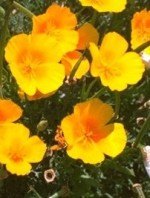 California poppy is one of the toughest, easiest to grow plants. It is native to the west coast from southern Washington to Baja California and east to Nevada, Arizona, and New Mexico, but it can be grown almost anywhere in the US. It is a short lived perennial in most of its natural range but annual where winters go below 20o F. It likes lean dry soil and is often found growing along roadsides or other disturbed areas and is ideal for arid conditions. The bright 4″ wide yellow to orange flowers have a satiny sheen and grow on a delicate plant with fine, ferny blue-green leaves. Although the native poppies have four simple petals new varieties may have double or frilled flowers. The flowers close at night and on cloudy or windy days and are not suitable for indoors. Plants reseed readily and can easily fill an area but will probably revert to the common species over time. A field of these poppies is an awesome sight; no wonder it is the state flower of California. Nice choice for wildflower, native plant, cottage, and meadow gardens. The genus name, Eschscholzia honors Johann Friedrich Eschscholta (1793-1831) of Tartu, Estonia, who accompanied Otto von Kotzebue on his first expedition round the world. The specific epithet, californica, refers to the native habitat of the plant.
California poppy is one of the toughest, easiest to grow plants. It is native to the west coast from southern Washington to Baja California and east to Nevada, Arizona, and New Mexico, but it can be grown almost anywhere in the US. It is a short lived perennial in most of its natural range but annual where winters go below 20o F. It likes lean dry soil and is often found growing along roadsides or other disturbed areas and is ideal for arid conditions. The bright 4″ wide yellow to orange flowers have a satiny sheen and grow on a delicate plant with fine, ferny blue-green leaves. Although the native poppies have four simple petals new varieties may have double or frilled flowers. The flowers close at night and on cloudy or windy days and are not suitable for indoors. Plants reseed readily and can easily fill an area but will probably revert to the common species over time. A field of these poppies is an awesome sight; no wonder it is the state flower of California. Nice choice for wildflower, native plant, cottage, and meadow gardens. The genus name, Eschscholzia honors Johann Friedrich Eschscholta (1793-1831) of Tartu, Estonia, who accompanied Otto von Kotzebue on his first expedition round the world. The specific epithet, californica, refers to the native habitat of the plant.
Type: Tender perennial often grown as an annual
Bloom: Yellow to orange flowers two to four inches across are produced singly on slender stems in late winter into summer. New varieties may be rose, pink, cream or white, and be double or frilled.
Foliage: Fine, fern-like gray-green leaves
Size: 12-18” H x 6-10″ W
Light: Full sun
Soil: Lean, very well-drained, sandy soil but tolerates less as long as its roots are not wet for prolonged periods.
Fertilizer: None
Hardiness: Zones 9-10 as perennial
Care: Low maintenance
Pests and Diseases: None of significance
Propagation: Seed (direct sow as plants resent transplanting)
Companion plants: Outstanding for wildflower mix
Outstanding Selections:

-
- ‘Alba’ (white)

-
- ‘Mission Bells’ (double, cream, pink, orange)

- ‘Rosea’ (pink)
